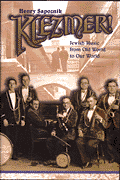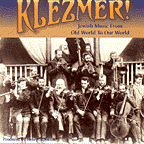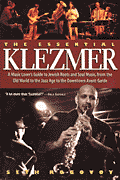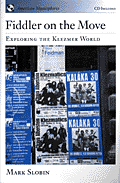Note that the latest stuff may not yet be indexed.
Jim Rebhan writes about Sapoznik's book, 1999
Allan Kozinn, of the New York Times, reviews both Sapoznik's and Rogovoy's books, Aug 2000
George Robinson interviews Mark Slobin about Beregovski's work, the klezmer revival, and more, Aug 2001.
For a complete bibliography of books and articles relevant to klezmer, see the "KlezWords" page.
Finally! Books about Klezmer, for the uninitiated
Sapoznik, Henry / Klezmer! Jewish Music from Old World to Our World, 1999
Rogovoy, Seth / The Essential Klezmer, 2000
Slobin, Mark / Fiddler on the Move, 2000
It's taken a long time for books to appear on the klezmer revival. There still isn't a great book on the revival--one that you'd feel comfortable assigning to students doing research. But these first three all have some very wonderful strengths, and will all three bring pleasure to their readers.
There is a fourth text out, by Joel Rubin, available only in German. Rubin's summary of the klezmer revival, printed in the liner notes of the masterful set of klezmer collections he and Rita Ottens assembled a few years ago (Doyres, Shteygers, Yikhes--I haven't yet heard the latest, Oystres) is still the best scholary--and most readable--summary of modern klezmer music and of the klezmer revival available. But, the opening chapter of his book, based on the reactions of scholars with whom I have spoken, is closer to a National Enquirer or Weekly World News version of klezmer history, and may not be at the level one would have assumed. Having said that, I cannot stress with sufficient pleasure what good notes (and what excellent music selections) the CDs contain.
 Sapoznik, Henry / Klezmer! Jewish Music from Old World to New World, originally Schirmer, now Music Sales Corp; ISBN: 0825671914
Sapoznik, Henry / Klezmer! Jewish Music from Old World to New World, originally Schirmer, now Music Sales Corp; ISBN: 0825671914
It's already two years since Henry Sapoznik's book became available, although Amazon.com insists that it was published in Dec. 2000. As one of the main people behind the Klezmer Revival, co-founder of one of the first revival bands (Kapelye), co-founder of one of the revival's most important institutions (if not the most important institution), KlezKamp, and an excellent story-teller, we all looked forward to this book. Unfortunately, somewhere between the book's inception and its publication, someone decided that it needed to be a history of Klezmer, rather than a chance for Henry to write about those things he knows so well: American Yiddish music discography, and his own memoir of participation in the Klezmer Revival. So, the book begins with some awkwardly cobbled together early klezmer research done by other people (and poorly credited to those people), personalized with a few paragraphs about Rovne, the town to which his grandfather emigrated as a youth in 1899, in which the stories are crowded out by the desire to pass this off as a more scholarly version of history.
Here's the thing, though. Sapoznik does know American Yiddish music recordings. When he begins talking about American Jewish music, the book starts to take off. Not a historian, and not a sociologist, Sapoznik doesn't provide as convincing a context as might otherwise be the case--the history of American Jewish music is more of a discography than history, but the quotes from Jewish musicians of early in the 20th century, as well as his discographies, are great. Fact checking can be careless. One reader complained to me that two or four different dates were offered for the release of Molly Picon's "Yidl mitn fidl," one of the most memorable of the Yiddish movies, and certainly the one most associated with klezmer music. I would suspect that the discographies, however, do stand up to scrutiny, and are far more careful.
When Sapoznik moves into the discussion of the Klezmer Revival, he proves to be a excellent, if biased observer. This is the first memoir of something that began over 25 years ago, and Sapoznik sets a high standard in terms of making the revival real, and in making it compelling. As with most memoirs, there is a tendency to exagerate the already-considerable, which is unfortunate. Thus, the reader who has only this resource might not realize that Sapoznik was not the sole founder of KlezKamp (Adrienne Cooper was co-founder, and has been an important participant through the years). Relying solely on the narrative, Sapoznik is also responsible for "Partisans of Vilna", the ground-breaking, emmy-nominated soundtrack created by Josh Waletzky for Waletzky's film of the same name. Given Sapoznik's real accomplishments, attempting to take credit for that he didn't do is unfortunate, and does not place him in the best light. Nor is Sapoznik shy about settling some personal scores. Waletzky may be the only co-founder of Kapelye not credited as such--something as a shock given Waletzky's influence, or the use of his tunes in other bands (i.e., recordings by the Klezmer Conservatory Band and Klezamir). Sapoznik's dismissal of Joel Rubin's clarinet playing is witty, but also somewhat unfair (those who have heard Rubin's playing with Josh Horowitz, the first Brave Old World album, or best, with the Epstein Brothers, would suggest more than "somewhat" unfair). These things matter much to the people involved, and certainly matter historically. But I'm not sure I would want to lose sight of the overall book because of them. One ends up emphasizing that this is memoir, not history. One also emphasizes that the memoir part, by a key participant in the revival, is fascinating and well-worth-reading as memoir. If you skip the history pastiche that opens the book, this book is very much a pleasure.
 There is a CD of the same name created to accompany this book. Although the two are not bundled together, I assume that the book is intended to be the liner notes for the CD, which is otherwise without annotation. The CD contains some essential and fun klezmer recordings and should also be considered by the reader interested in this subject.
There is a CD of the same name created to accompany this book. Although the two are not bundled together, I assume that the book is intended to be the liner notes for the CD, which is otherwise without annotation. The CD contains some essential and fun klezmer recordings and should also be considered by the reader interested in this subject.
 Rogovoy, Seth / The Essential Klezmer, 2000, Algonquin Books of Chapel Hill. ISBN: 1-56512-244-5
Rogovoy, Seth / The Essential Klezmer, 2000, Algonquin Books of Chapel Hill. ISBN: 1-56512-244-5
This really is an essential book for afficionados of klezmer as a genre. Rogovoy does an excellent job of covering the klezmer revival from the standpoint of a fan who is drawn to the music both because of the way it tugs at his sense of "Jewish" and because of the compelling qualities of the music, itself. The only major weakness in the book is, again, in the early section about klezmer in Europe, in which it isn't clear that Rogovoy is as deeply knowledgeable in Jewish culture and/or in European Jewish history as might be the case. It is unlikely that many readers of this book will find this a problem.
This book is a disc-lover's Paradise. Not only does journalist Rogovoy, who has written extensively in recent years about Jewish musicians as diverse as Andy Statman and the Klezmatics, write well, and personably, but his writing conveys the excitement and love for the music that motivated the book. If you are remotely curious about klezmer music, this is a fascinating, pleasurable, and rewarding place to start. To aid the collector, Rogovoy includes a huge discography (not as extensive as that available here, but certainly, by orders of magnitude, the largest in print), as well as a short glossary, a klezmer categorization, and a host of reference materials for the person who wishes to go further.
If I have a complaint, it is that this is a klezmer fan's book, not an historical text. Nor does the author seem to have an overall sense of Jewish music. All Jewish music, instead, seems to be seen as a variant of klezmer! The book is also quite American-centric. Israel, Europe, and the rest of the world get short shrift. Given that the "klezmer revival" is, by and large, an American-driven phenomenon, that is understandable, but it does note limits to the author's insights. There is no equivalent here to Heiko Lehmann's discussion of Jewish music in Eastern Europe, as presented in Sapoznik's book, which offers some vital insight into the popularity of things Jewish in Germany. (For more on that complex subject, of course, readers would best turn to Ruth Ellen Gruber's fascinating and new, as of this writing "Virtually Jewish: Reinventing Jewish Culture in Europe".)
These complaints matter, however, only if one attempts to take this extraordinary fan's book and serve it up as definitive history. What Rogovoy offers is not only a fan's view, but an ability to appreciate the diversity of the post-revival klezmer world. Unlike most writers, he is equally comfortable discussing the New Orleans Klezmer AllStars, Naftule's Dream, or the Klezmatics as he is in discussing Andy Statman or the Klezmer Conservatory Band. In recommending this book to friends interested in the music that has provided me with so much pleasure, I tell them how good the book is at what it was written to do: to present and to empower those ready to explore klezmer with the story of the klezmer revival, interviews and stories, ample CD reviews, and a love of the music.
 Slobin, Mark / Fiddler on the Move, 2000, Oxford University Press, www.oup.com. CD included.
Slobin, Mark / Fiddler on the Move, 2000, Oxford University Press, www.oup.com. CD included.
Mark Slobin is probably the person best-placed to write about the klezmer revival. He has not only written extensively about Eastern European folk musics (including translations of Moshe Beregovski's work into English), but may have been the first Jewish ethnomusicologist to see that the klezmer revival was relevant to Jewish music and Jewish community. Certainly, his landmark work in gathering several papers on klezmer and on the klezmer revival in the Winter 1998 issue of "Judaism" is the best and broadest snapshot of the revival extant.
Here, Slobin puts the revival into a cultural and musical context that will be sheer delight to people engaged in playing the music, or wanting to understand that context better. Although the book does not say much about actually playing the music--it is more of work of sociology than of musicology--Slobin's insights and breadth of understanding contribute to an enormously wonderful volume. He not only discusses how the term "klezmer music" came to be attached to this music (formerly, "Jewish music" or "Jewish wedding music" to the Eastern/Central European practitioners who performed it in this country), but the ways in which the music has become a genre and a marketing tool:
For klezmer, far more common than plans for media marketing is the strategizing of the local working band, which features the eclectic mix of music that klezmorim have always offered the playing public. It is hard to tell "klezmer" bands from general "Jewish" bands, which have always existed locally and are now using the world "klezmer" as part of marketing.... [p. 39]
But Slobin also does extensive interviews with klezmer musicians and demonstrates the diversity of reasons people came to play this music--this is what the paying customers wanted, this is the music that mattered, this is the music that had cultural significance for me. He also discusses how the modern wedding band fills an educational purpose that didn't exist and wasn't necessary (or relevant) 100 years ago, as with this quote by Yosl Kurland, of Wholesale Klezmer:
When you hire the Wholesale Klezmer Band, you're also hiring someone who's going to teach you how to do a traditional wedding. Not the khupe part [the ceremony proper] necessarily, that's the rabbi's job, but everything else. People have called and said, "We'd like to have Jewish music, but we'd also like to have a pop band for dancing." I'll show you how to dance. You'll be so occupied with Jewish dancing that you won't have time for the other kinds of dancing. You don't need a partner, and you don't have to know what to do.... [p. 79]
For me, this is the first book about klezmer music and about the klezmer revival that offers perspective and grounded historical fact. It's not a book for fans--this is not a good place to get a top 10 list, or from which to decide album to purchase first or next (for that, consult Rogovoy's book, or even the KlezmerShack). But if, like me, you are interested into how this fits into how we are Jewish (or are not Jewish) today, if, like me, you want to understand more about the context of klezmer, here in the US, or around the world, this is such an excellent book. Once again, Mark Slobin writes the (so-far) definitive work. This is a book that was needed. Now I look forward to the next volume.

